16 Ideal Tank Mates to Pair With Neon Tetras - AZ Animals
More Great Content:
One of the smallest and most popular schooling fish in aquariums happens to be neon tetras. These fish are easily recognized by their neon red and blue coloration, with a maximum size of 1.5 inches long. Neon tetras are freshwater fish originating from tropical South American waters and belong to the Paracheirodon genus.
They are often chosen for nano or community aquariums because they are easy to care for, peaceful, and hardy. Neon tetras rarely display aggressive behaviors, so they get along with many other fish and invertebrates.
This article will list and discuss the 16 ideal tank mates you can pair with neon tetras.
Species Profile: Neon Tetras

©iStock.com/Mirko_Rosenau
| Scientific name: | Paracheirodon innesi |
| Origins: | South America |
| Size: | 1 to 1.5 inches |
| Lifespan: | 5 to 8 years |
| Diet: | Omnivores |
| Temperature: | 72° to 78° Fahrenheit (22° to 26° Celsius) |
| PH range: | 5.0 to 7.5 |
| Tank size (minimum): | 10 gallons (45 litres) |
According to the U.S. Fish and Wildlife Service, neon tetras need to be kept in groups of five or more. They are a social species that form same-specie schools in the wild. You should only choose tank mates for neon tetras once you are keeping them in groups. Their tank mates should be other peaceful and small fish or invertebrates that thrive at similar water parameters to neon tetras. As tropical fish, neon tetras only pair well with tank mates that require an aquarium heater.
While the starting tank size for a group of five to six neon tetras is 10 gallons, this will need to be increased if you plan to keep them with tank mates. A 25-gallon long aquarium is a good starter size for a group of neon tetras and one or two small tank mates.
The Best Species Of Fish To Pair With Neon Tetras
1. Zebra Danios (Brachydanio rerio)

©iStock.com/MATTHIASRABBIONE
One of the most common fish species paired with neon tetras is zebra danios. They are both similar in size at 1 to 1.5 inches long, although zebra danios stand out with their colorful striped bodies. Zebra danios are relatively peaceful fish that need to be kept in groups of six or more because they are schooling fish. They do not pose a threat to neon tetras in aquariums and swim at the same water levels, usually near the mid and top sections.
2. Harlequin Rasboras (Trigonostigma heteromorpha)

©JuanCarlosPalauDiaz/Shutterstock.com
Harlequin rasboras are vibrantly colored freshwater fish hailing from southern Thailand, Singapore, and Sumatra. They are small fish at only 2 inches long and recognized by their reddish-orange bodies. Harlequin rasboras have a distinctive triangular marking near their caudal fin that makes them stand out against other rasbora fish. In an aquarium, harlequin rasboras will form schools so they should be kept in groups of at least six to eight. Neon tetras and harlequin rasboras can get along well in aquariums and share similar dietary requirements.
3. Mollies (Poecilia sphenops)
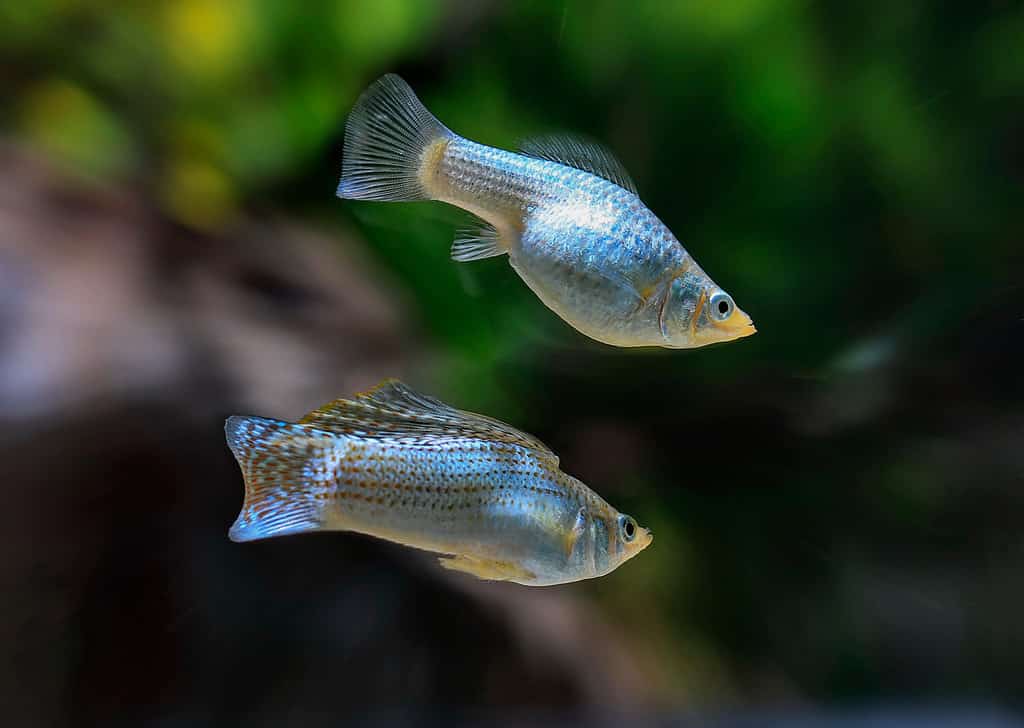
©Mr.Sutun photographer/Shutterstock.com
Mollies are live-bearing fish from the Poeciliidae family that give birth to free-swimming fry. They are peaceful omnivores that primarily feed on algae, worms, brine shrimp, and various commercial fish foods such as flakes. They can be found in various color forms and fin types, with black and silver being the most popular. Mollies can reach up to 5 inches long as adults, but their mouths are usually too small to eat neon tetras.
However, mollies do not actively hunt other fish and keep to themselves in aquariums. Due to the molly's size and schooling requirement of five or more, a tank over 25 gallons is recommended if you keep them with neon tetras.
4. Lemon Tetras (Hyphessobrycon pulchripinnis)
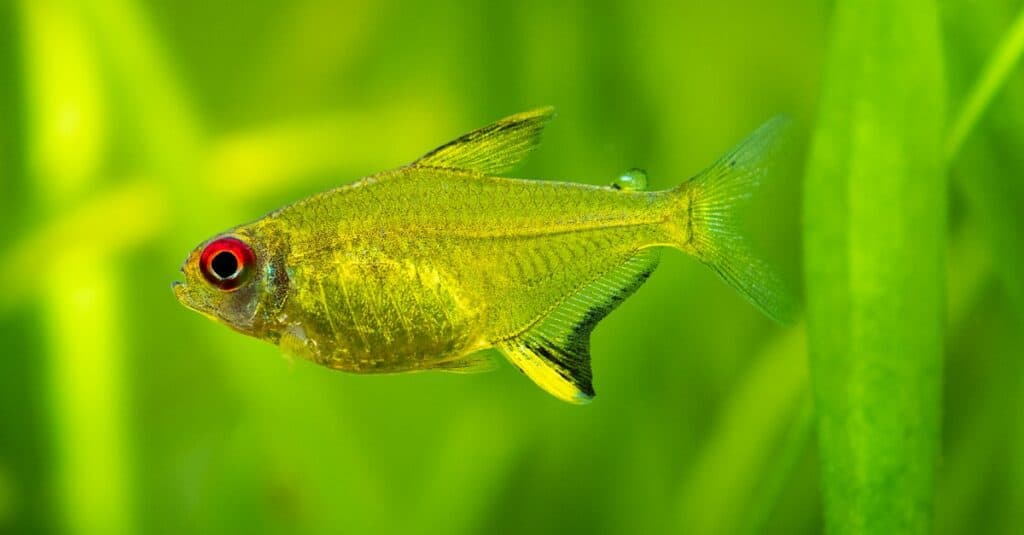
©iStock.com/Juan Carlos Juarez Jaramillo
Lemon tetras are one of the most colorful tank mates you can keep with neon tetras. Their bodies are a striking yellow coloration, hence their name. Lemon tetras typically grow to around 2 inches in size and live for around 5 years. They are easy to care for and can live in the same water conditions and temperature as neon tetras.
Much like neon tetras, lemon tetras are a social species that should be kept in groups. Lemon tetras are generally more active and lively in an aquarium with live plants, and driftwood, and when they can form schools.
5. White Cloud Mountain Minnows (Tanichthys albonubes)

©Besjunior/Shutterstock.com
The hardy white cloud mountain minnow is a favored species to keep with neon tetras, mainly because they have similar care requirements. White cloud mountain minnows are native to China and can adapt to both cold and warm waters, including the neon tetras tropical conditions. They have a similar size and body shape to neon tetras, usually growing 1.5 inches long. Their bodies are an iridescent silverish blue coloration paired with a distinctive horizontal stripe. White cloud mountain minnows have reddish-orange fins and a black dot at the base of their caudal fin.
6. Guppies (Poecilia reticulata)

©Grigorev Mikhail/Shutterstock.com
Guppies are incredibly popular aquarium fish that have been kept as pets for more than a century. They are live-bearing fish that are characterized by their small bodies and wide range of colors, patterns, and fin shapes. Most guppies grow between 1.5 to 2 inches long, with females being slightly smaller than males. They are easy to care for and recommended for beginner aquariums because of their hardiness and adaptability in aquariums. A group of five to eight guppies can comfortably live with neon tetras in a 25-gallon aquarium with a filter, heater, and live plants.
7. Cory Catfish (Corydoras paleatus)
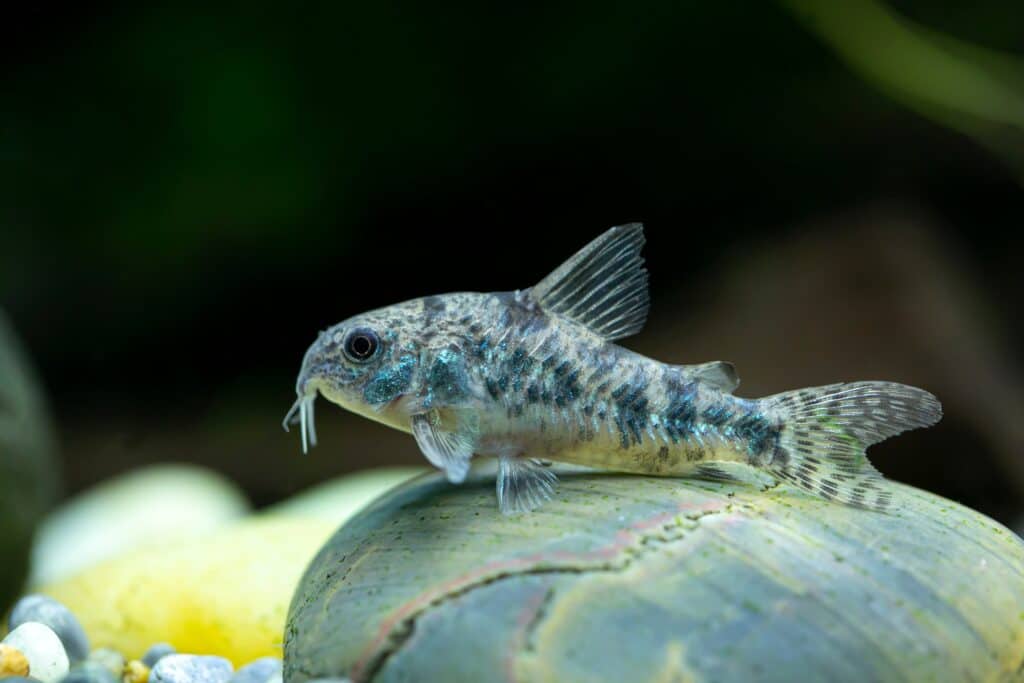
©boban_nz/Shutterstock.com
The popular bottom-dwelling cory catfish, also known as Corydoras, make perfect tank mates for neon tetras. Cory catfish originate from South America where they spend most of their time foraging for food along the substrate. There are different species of cory catfish, such as the bronze, peppered, or bandit. Most species of cory catfish live in the same aquarium as neon tetras. Both species rarely interact with each other because cory catfish inhabit the bottom of the aquarium.
As adults cory catfish usually reach 2 inches in size, but some species don't exceed 1.3 inches. Cory catfish are social fish, so you cannot keep them alone or in pairs. They need to be kept in groups of five or more so that they can interact together and socialize.
8. Swordtails (Xiphophorus helleri)
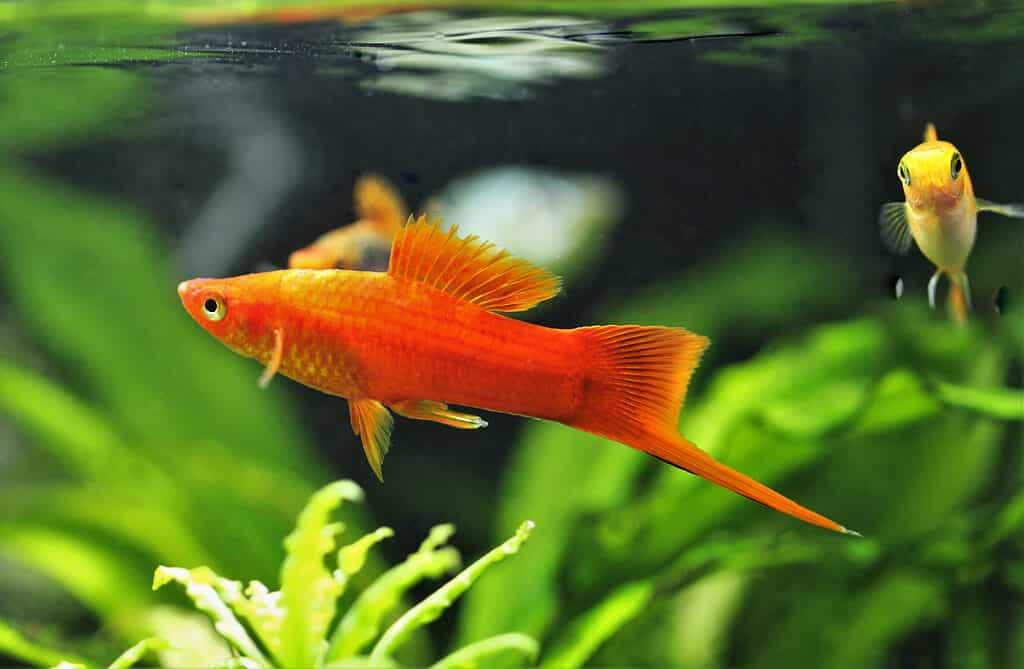
©Arunee Rodloy/Shutterstock.com
Swordtails are live-bearing fish like mollies and guppies but stand out with their elongated caudal fins. Their caudal fin resembles a sword as their name suggests, although it is only seen in males. Swordtails are peaceful freshwater fish that grow to around 5 inches long. They are available in numerous varieties, such as vivid oranges, reds, silver, and blue.
These peaceful fish can be colorful additions to neon tetra aquariums and adapt well to the same water conditions. However, swordtails can be sensitive to water quality and are sensitive to even the slightest traces of ammonia or nitrite in the water. Swords should only be kept in mature neon tetra aquariums, and preferably in groups of five or more.
9. Kuhli Loaches (Acanthophthalmus kuhlii)
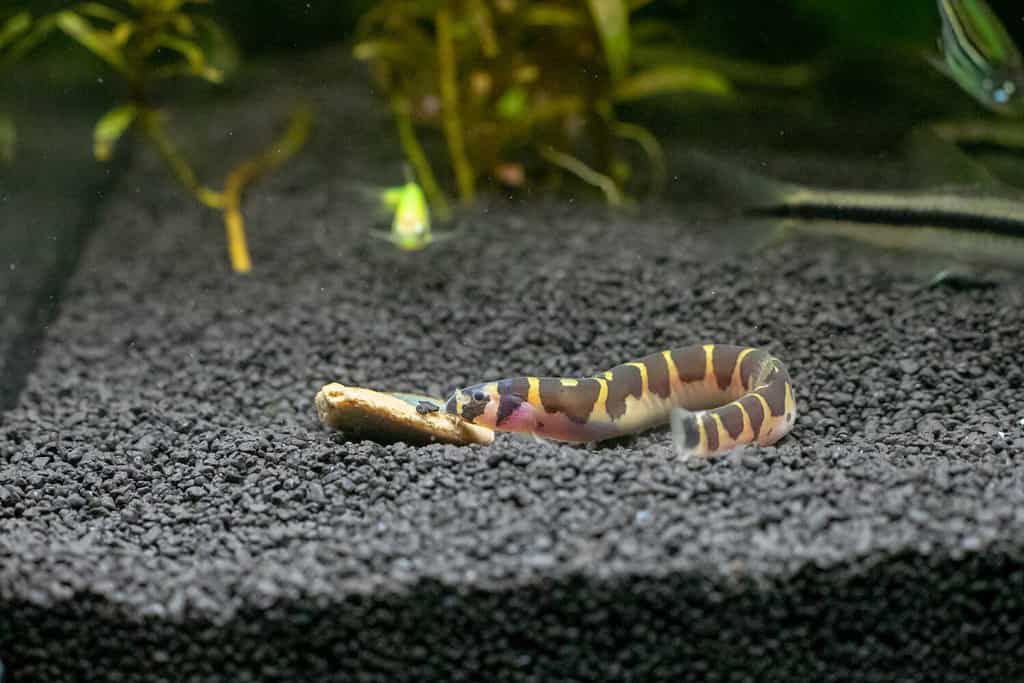
©Olga Chezhina/Shutterstock.com
Kuhli loaches are eel-shaped fish part of the Cobitidae family. The most popular species kept in aquariums grows to 4 inches long and has a brown and yellow banded body. Kuhli loaches do not take up a lot of space in aquariums even though they need to be kept in groups of at least five. They are naturally tropical fish that can live within the same temperature range as neon tetras with few problems. Kuhli loaches are bottom-dwellers and hide most of the day because they are nocturnal. They should be kept in neon tetra aquariums with a soft sandy substrate or fine gravel so that they can burrow.
10. Bristlenose Plecostomus (Ancistrus cirrhosis)
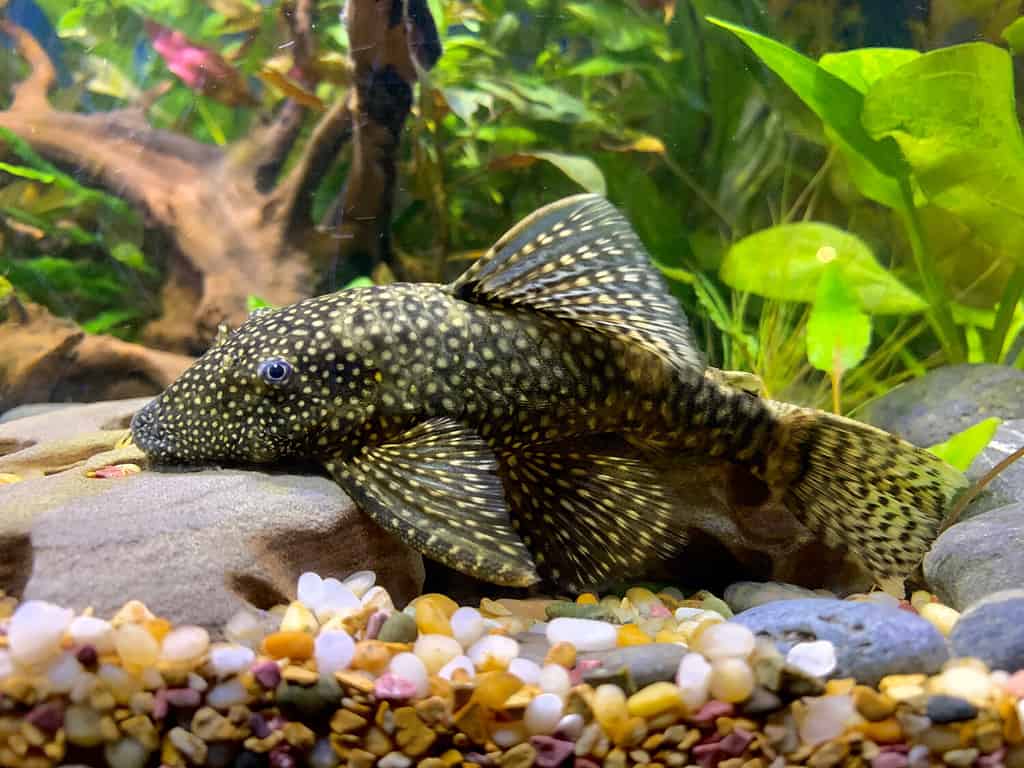
©TTONN/Shutterstock.com
Another peaceful bottom-dwelling fish that can be kept with neon tetras is bristlenose plecos. They are freshwater catfish native to South America which grow around 5 to 6 inches long. Male bristlenose plecos have multiple tentacle-like growths on their face, whereas females only have a few short ones. Bristlenose plecos are bottom-dwelling fish that do not need to be kept in large groups like most of the neon tetra tank mates mentioned in this article. They can be kept in pairs or groups of three or four if the tank space allows it.
Furthermore, they are easy to care for which is why they are recommended for beginner fish keepers. If you keep them with neon tetras, be sure to add driftwood to their aquarium. Bristlenose plecos enjoy eating driftwood as part of their diet.
11. Platies (Xiphophorus maculatus)
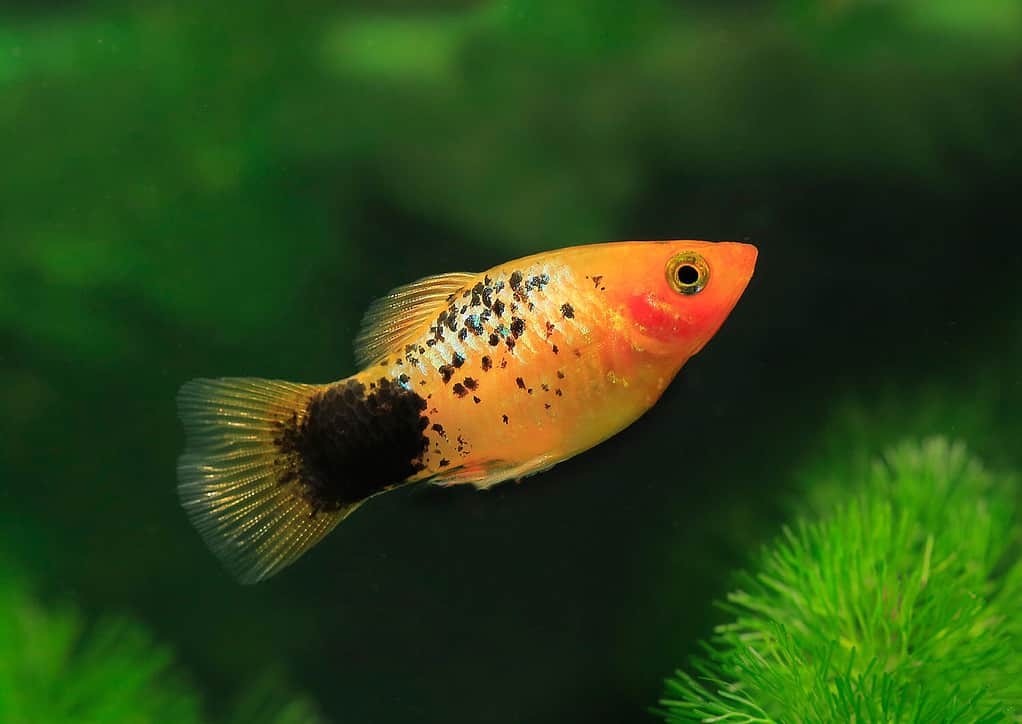
©R. Maximiliane/Shutterstock.com
Platies are another type of live-bearing that can be a good tank mate for neon tetras. They are social, peaceful, and adaptable fish that can be found in an array of colors and patterns. Platies are often confused for female swordtails or males, primarily because they have a similar body shape and adult size of 3 to 5 inches long. Platies should be kept in groups because they are social fish, and their minimum tank size is around 20 gallons in size. However, this tank size should be increased to 25 gallons if you keep them with neon tetras.
12. Panda Tetras (Aphyocharax paraguayensis)
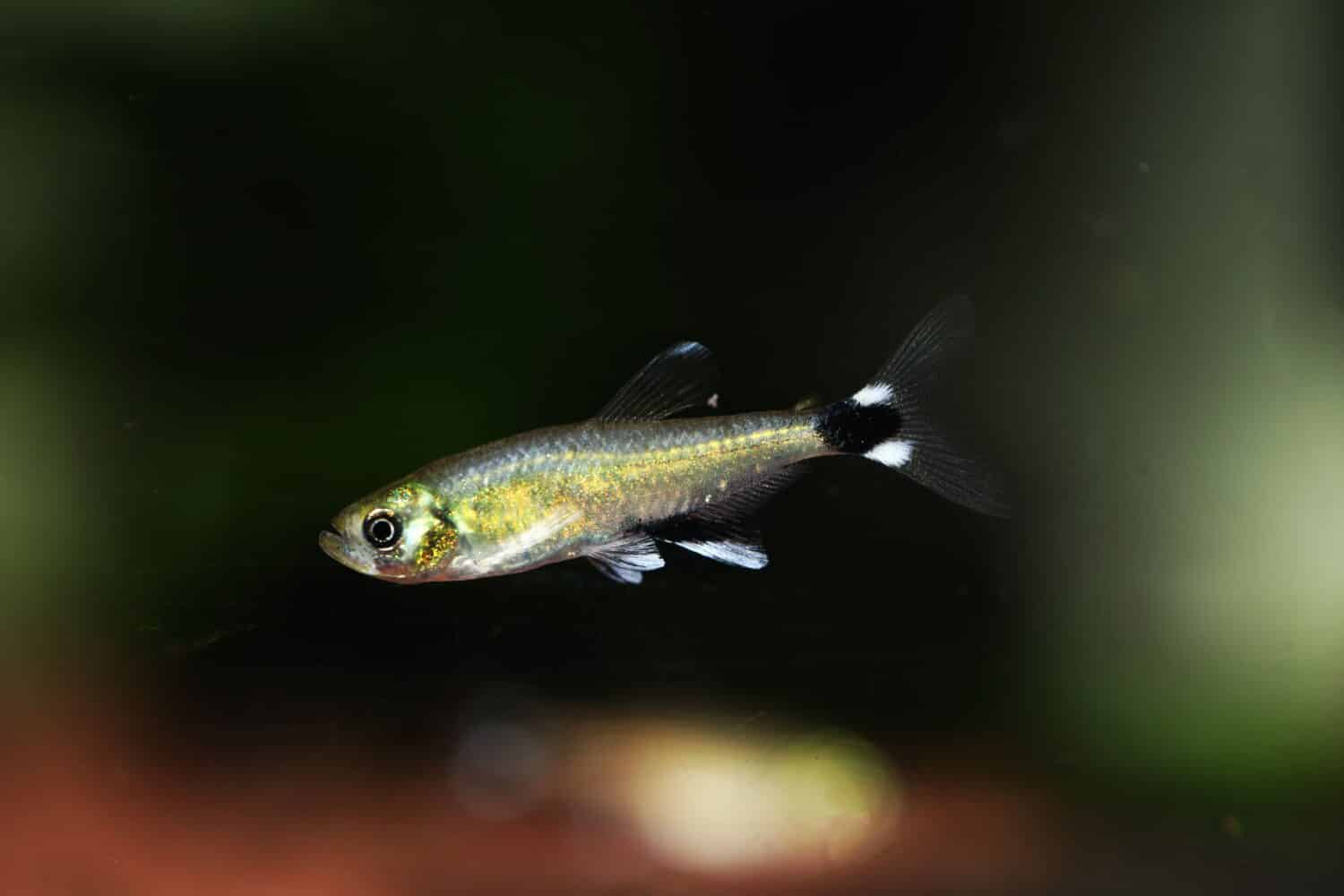
©Pavaphon Supanantananont/Shutterstock.com
Panda tetras are peaceful and social schooling fish that have a relatively plain appearance when compared to neon tetras. They originate from the warm South American waters, specifically from Paraguay and Brazil. Panda tetras have stunning reflective silver-greenish-blue bodies and a relatively small size of 1.5 inches long.
You can offer panda tetras the same foods as neon tetras because they are omnivores. They thrive on a varied diet of tropical fish flakes or pellets alongside live foods like brine shrimp and bloodworms. Panda tetras do not have very demanding tank size requirements because of their small size.
Most panda tetras are comfortable in a 20-gallon aquarium in groups of five or more. The aquarium will need to be fully cycled, heated, and filtered and at the same temperature as neon tetras require.
13. Cardinal Tetras (Paracheirodon axelrodi)
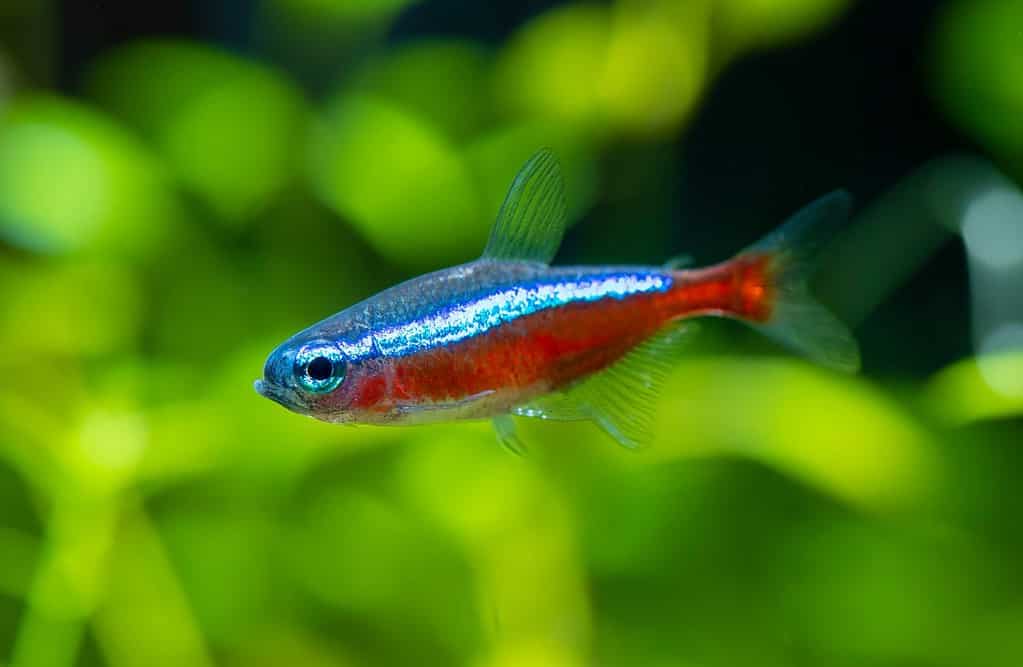
©NattapolStudiO/Shutterstock.com
Neon tetras and cardinal tetras are sometimes confused for the same species. They both belong to the Paracheirodon genus, but they are different species. However, cardinal tetras can still be housed with neon tetras if they are still kept in same-specie groups. This means that cardinal tetras cannot be kept alone or in pairs to form part of a neon tetras school.
The most significant difference between cardinal tetras and neon tetras is their appearance. Otherwise, their behaviors, diet, and water conditions are all similar. Cardinal tetras are larger than neon tetras at 2 inches long and have fuller red and blue markings. The red part of cardinal tetras extends from their gills to the caudal fin, which ends halfway in neon tetras.
The Best Invertebrate Tank Mates For Neon Tetras
Fish are not the only tank mates known to get along with neon tetras. Invertebrates like snails and shrimp can be some of the best tank mates for neon tetras.
1. Mystery Snails
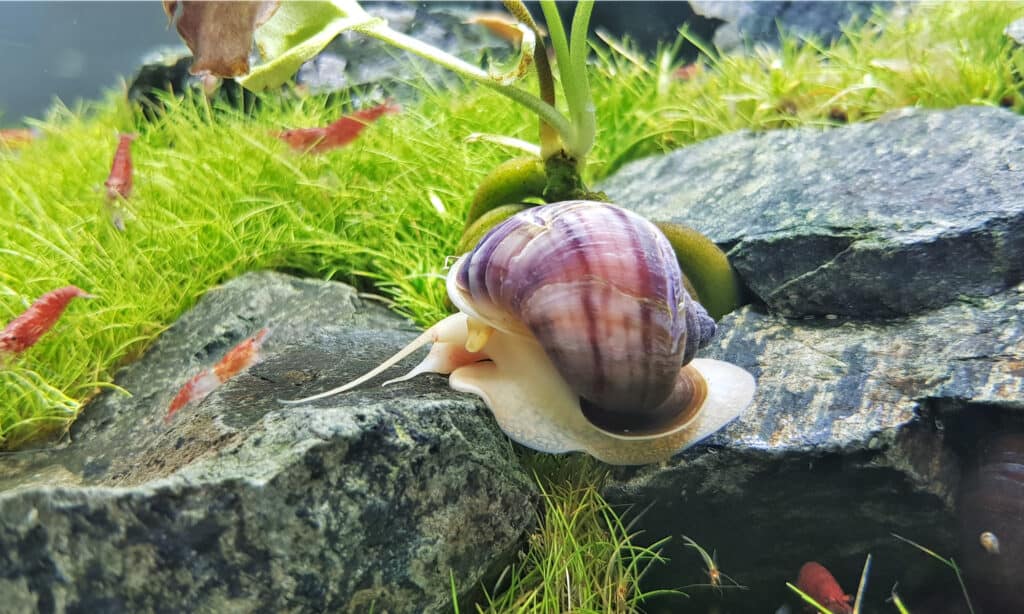
©Arunee Rodloy/Shutterstock.com
Mystery snails are large aquarium snails that generally grow to around 2 inches in size. These peaceful and active snails are known for their fascinating behaviors, prolific breeding habits, and undemanding care requirements. Mystery snails can also be found in numerous shell colorations, including standard gold or chestnut, or more unusual colors like purple and blue.
You do not have to keep mystery snails in groups, nor do you have to upgrade your neon tetras aquarium to keep them as tank mates. A single mystery snail can thrive in a 10-to-20-gallon neon tetra aquarium as long as the water is kept heated and filtered.
A bonus to keeping mystery snails over other species of snails as tank mates is that rarely eat live aquarium plants.
2. Neocaridina Shrimp
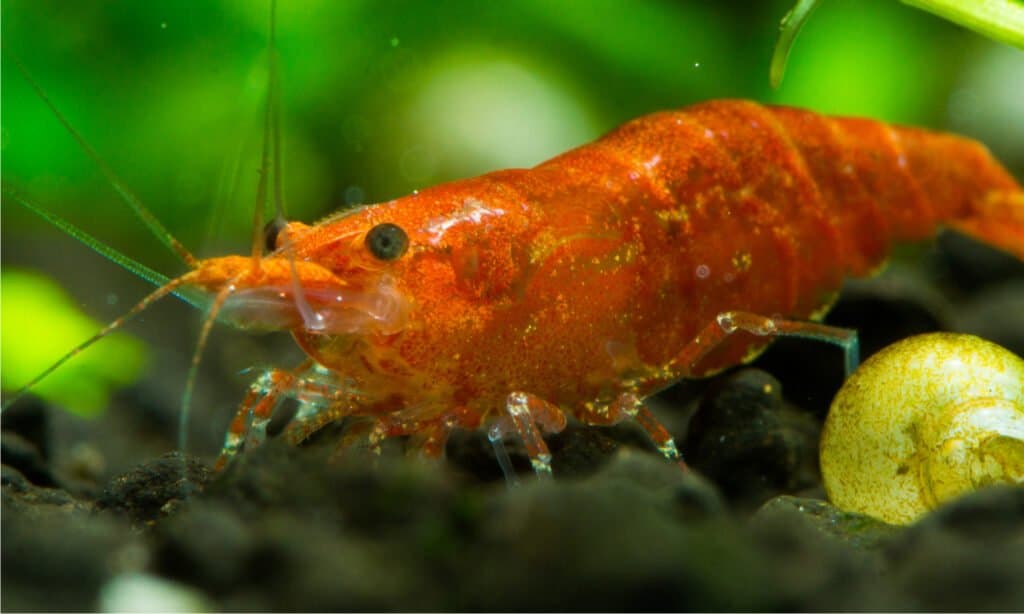
©DavidTing/Shutterstock.com
Although neon tetra will accept small species of shrimp as a food source, it is possible to keep them together. Neocardina shrimp are popular freshwater shrimp that originate from Taiwan. They are small shrimp at only 1 inch long and can be found in many different color forms that are sold under interesting names. Cherry, blue velvet, jade, and red rili are some of the most common types of Neocaridina bred and raised in aquariums.
Nearly all types of adult neocaridina shrimp are compatible tank mates for neon tetras in the right conditions. You will need to keep them in the same aquarium conditions as neon tetras, but the aquarium needs to be heavily planted. Neon tetras will pick on any shrimp they can find, so the aquarium must have plenty of hiding spaces in the form of rocks, bushy plants, and driftwood.
Java moss, hornwort, and water wisteria are often recommended for neocaridina shrimp to hide in and avoid predation.
3. Nerite Snails

©iStock.com/Juan Carlos Juarez Jaramillo
An excellent tank cleaner for neon tetra aquariums is nerite snails, which are easy to maintain in aquariums. Nerite snails are small freshwater and brackish water snails that only grow an inch long. They are preferred over other aquarium snails because of their breeding habitats. Nerite snail eggs can only hatch in brackish water, so they are unlikely to overpopulate your neon tetra aquarium. Nerite snails enjoy eating green algae, but they will clean up any leftover fish food that your neon tetras miss. They can be kept alone or in groups, and do not take up much space in aquariums.
Conclusion
Neon tetras are the perfect community fish with their small size and peaceful temperaments. The best tank mates for neon tetras are other small, peaceful, and social fish that can live in the same water conditions. Their ideal tank mates include bottom-dwelling fish like cory catfish, followed by other fish like guppies, or freshwater snails.
Summary Of The 16 Best Tank Mates To Pair With Neon Tetras
| 1 | Zebra danios |
| 2 | Harlequin rasboras |
| 3 | Mollies |
| 4 | Lemon tetras |
| 5 | White cloud mountain minnows |
| 6 | Guppies |
| 7 | Cory catfish |
| 8 | Swordtails |
| 9 | Kuhli loaches |
| 10 | Bristlenose plecos |
| 11 | Platies |
| 12 | Panda tetras |
| 13 | Cardinal tetras |
| 14 | Mystery snails |
| 15 | Neocaridina shrimp |
| 16 | Nerite snails |
Comments
Post a Comment